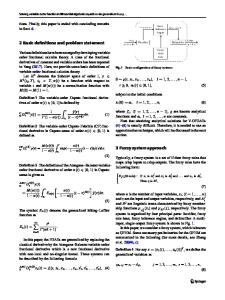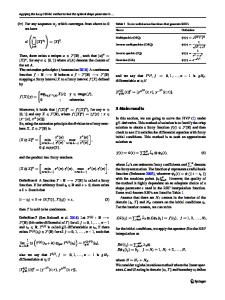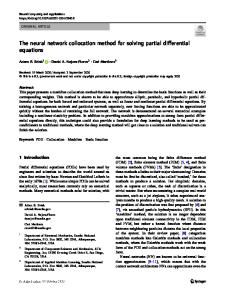Computational procedure for solving fuzzy equations
- PDF / 498,528 Bytes
- 15 Pages / 595.276 x 790.866 pts Page_size
- 62 Downloads / 367 Views
METHODOLOGIES AND APPLICATION
Computational procedure for solving fuzzy equations F. Abbasi1 · T. Allahviranloo2
© Springer-Verlag GmbH Germany, part of Springer Nature 2020
Abstract The classical methods for solving fuzzy equations are very limited because, often, there are no solutions or very strong conditions for the equations it is placed to have a solution. In addition, the solution’s support obtained in these methods is large. All of this is due to the consideration of operations related to equations based on the principle of extension, which is due to the absence of ineffective members. These high points are our motive for achieving a new approach to solving fuzzy equations. We will solve the fuzzy equations, taking into account the fuzzy operations involved in the equation based on the transmission average by Abbasi et al. (J Intell Fuzzy Syst 29:851–861, 2015). In this paper, a computational procedure is proposed to solve the fuzzy equations that meets the defects of previous techniques, specially reluctant to question whether the answer is valid in the equation. The proposed approach is implemented on the fuzzy equations as AX + B = C, AX 2 + B X + C = D, AX 3 + B X 2 = C X . At the end, it is shown that the solution of the proposed method in comparison with other methods of solving fuzzy equations are more realistic, that is, they have smaller support. Keywords Fuzzy arithmetics · Fuzzy equation · Extension principle (EP) · Transmission average (TA)
1 Introduction Fuzzy mathematics is a tool for advanced modeling. In such advanced modeling, the most valuable work is fuzzy modeling, which is not the main purpose of this paper. The purpose of the paper is to attribute several fuzzy numbers as the solutions to a fuzzy special model under the name of fuzzy equations. Fuzzy equations consisting of an unknown variable, fuzzy constant coefficients, and an equality relationship with the fuzzy operations involved in it. Therefore, the assignment of fuzzy numbers, called solutions should be done with the help of inverse fuzzy operations involved in the equation. Solving fuzzy equations has always been an active area of research. Fuzzy equations were investigated by Dubois and Prade (1984). Sanchez (1984) had proposed a solution of fuzzy equation by using extended operations. Accordingly various researchers have proposed Communicated by V. Loia.
B
F. Abbasi [email protected]
1
Department of Mathematics, Ayatollah Amoli Branch, Islamic Azad University, Amol, Iran
2
Faculty of Engineering and Natural Sciences, Bahcesehir University, Istanbul, Turkey
different methods for solving the fuzzy equations (Buckley 1992; Wasowski 1997; Biacino and Lettieri 1989; Jiang 1986; Buckley and Qu 1990; Kawaguchi and Date 1993; Zhao and Govind 1991; Wang and Ha 1994; Mazarbhuiya 2011; Buckley et al. 1997). If the operations involved in fuzzy equations are based on the extension principle (α-cut ), then due to the lack of ineffective members in addition and multiplication such operations, it is possible to use classic
Data Loading...











